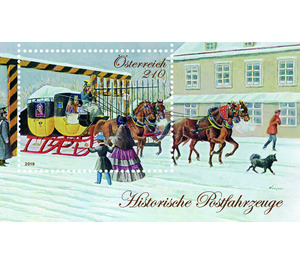Series: Historical postal vehicles - Royal and Imperial Express Mail - the Mariahilf Line - Austria / II. Republic of Austria 2019
Theme: Traffic, Transportation & Mobility
| Country | Austria / II. Republic of Austria |
| Issue Date | 2019 |
| Color | multi-colored brown white |
| Item Type | Block |
| SID | 923519 |
| Dimensions | 100.00 x 60.00 |
| In 64 Wishlists | |
Royal and Imperial Express Mail – the Mariahilf Line - The fast way to travel: This year’s mini sheet from the popular “Historical postal vehicles” series shows a Royal and Imperial Express coach just arriving in Vienna, set against a wintry backdrop. The k.k. Eilpost (Royal and Imperial Express Mail) was founded in 1823 based on the English model. The first routes ran from Vienna to Brno, Prague and Pressburg with Graz and other important cities being added from 1824 on. The coaches were pulled by four horses and were designed to transport up to twelve passengers. The 19 postal miles from Vienna to Brno (today around 140 kilometres by road) could thus be covered in 14 hours, including a one hour break. Before starting on a journey with the express, a coach booking certificate and an entry ticket had to be redeemed. However, the advent of the railway ultimately led to the demise of the express mail coach for passengers. The mini sheet shows a design from a postcard from the year 1852. The postillion on the box is announcing the coach's arrival in Vienna on his post horn. The express mail, equipped for the winter with runners in place of wheels, is passing through the gate of the Mariahilf Line, which can be recognised by the black and gold beams and iron grille. The Linienwall Mariahilfer Straße was once a postal route used to convey both items of mail and passengers. In 1704 Emperor Leopold I ordered the building of a defensive fortification, the Linienwall, which enclosed the city in a semi-circle stretching from the Danube Canal at St. Marx to Lichtental in today’s 9th district. This was initially an earthen rampart with ditches, but was later fortified with bricks. Entrance gates and offices were set up on the major roads, constituting the “line”, where tolls were collected and, from 1829, also the consumption tax for the food brought into the city. The Mariahilf Line mentioned above was one of these. The Linienwall was primarily intended to protect Vienna and its suburbs against attacks by Hungarian rebels, the Kurucs, but it also became a social barrier, as life within the city walls was more expensive than outside because of the taxes levied there. The wall's ditches were later filled in and, once the suburbs were incorporated into the city, the Linienwall was torn down after 1894 and today’s Gürtel with its green spaces and the tram system were built.


